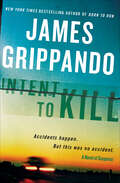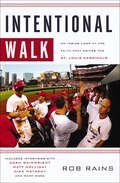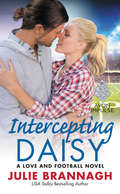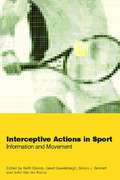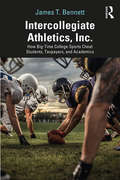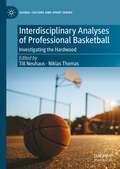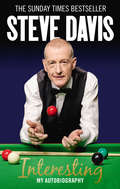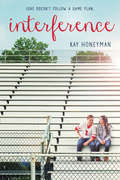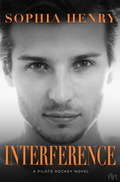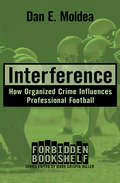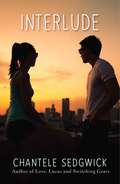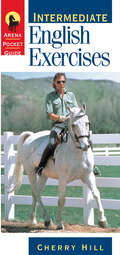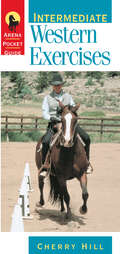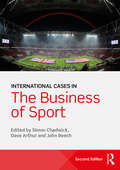- Table View
- List View
Integrity and Sustainability in Sport: Business, Environmental and Social Goals (Routledge Research in Sport Business and Management)
by Rob Wilson Daniel Rhind Tiberio Daddi Chris Horbel Stella Leivadi Timothy Kellison James Esson Agostino Vollero Argyro Elisavet Manoli Daniel Plumley Renan Petersen-Wagner Ioannis Konstantopoulos Lyndsey Fox Thadeu Gasparetto John Goedee John Hie Tero Kalsta Dimitrios Kolyperas Niki Koutrou Nanny Kuijsters-Timmers Roger Leenders Niccolò Maria Todaro Carolynne Mason Alessio Novi Riikka Rakic Bob Ramsak Josephine Traberg Eugenia Tzoumaka Serhat YilmazThis is the first book to examine the critically important topic of sustainability in sport through the lens of integrity. Adopting a holistic view on sustainability, it argues that integrity is the foundation on which sustainable sports organisations, actions and processes must be built.This book shows how the interconnected values of integrity and sustainability can be embedded in sporting organisations, policies and activities. Featuring the work of leading sport researchers from around the world, this book first presents a conceptual model and a framework for understanding sustainability and integrity as applied to sport. It then examines these concepts in the context of sport business, the natural and built environments and wider society, covering important contemporary issues such as mega‑events, legacy, sport governance, climate justice, sport stadia, sport for development, sport sponsorship and marketing and corporate social responsibility.Presenting cutting‑edge research and challenging sport practitioners to consider how to embed integrity and sustainability in their everyday work, this book is important reading for any student, researcher, practitioner or policymaker with an interest in sport, sustainable development and integrity.
Intent to Kill: A Novel of Suspense
by James GrippandoThe New York Times-bestselling author delivers a “tight, twisty thriller . . . Hums along like a sizzling fastball thrown straight and sure” (Providence Journal-Bulletin).Bestselling author James Grippando is back with a gripping stand-alone thriller. Intent to Kill electrifies from the first inning on—as a fallen baseball star-turned-sports radio “shock jock” tries to expose a conspiracy and outwit a killer. Crackling with Grippando’s trademark suspense, inventive plotting, and unforgettable characters, Intent to Kill is a grand slam from the author Nelson DeMille calls, “A very intense and ingenious storyteller.”“This book has it all: sports, crime, money, and romance . . . It’s a delight.” —The Charleston Post & Courier“A fine stand-alone thriller . . . Grippando readers who know him mostly from the Swyteck series may find themselves thinking: wow, this guy is really good.” —Booklist“Intent to Kill is one of those rare ‘WOW’ books. The characters are tightly defined; the mystery is just that—a very good mystery that will knock your socks off—along with a soupçon of romance, and a smooth and mesmerizing narrative.” —Fresh Fiction
Intentional Walk: An Inside Look at the Faith That Drives the St. Louis Cardinals
by Rob RainsAn inside look at the faith that guides the all-stars.The St. Louis Cardinals have long been one of the most successful franchises in the major leagues. They have won 11 World Series titles and some of the most famous players in the history of the game have worn the storied “Birds on the Bat” uniform.While that on-field success has been well documented, Intentional Walk is the first book which goes beyond the story of what happens on the field to take an in-depth look at the men inside the Cardinal uniforms, and examine how their strong Christian faith is one of the driving forces behind their success.Intentional Walk features the stories of Adam Wainwright, David Freese, Lance Berkman, Matt Holliday, Carlos Beltran, Jason Motte and other members of the 2012 Cardinals, written as those players and the rest of the team tried to repeat the 2011 world championship. The book talks about how they became Christians and offers their testimony about what it means for them to have God play such a prominent role in their lives.Playing for first-year manager Mike Matheny, a strong Christian as well, these men talk about their success and failure, about the challenges that come from playing baseball at the highest level, and how thankful and blessed they are to have that God-given ability. In the end, however, what is far more important to them is their life-long relationship they have established with Jesus Christ.
Intercepting Daisy: A Love and Football Novel
by Julie BrannaghWhen Daisy Spencer wrote an erotic novella about the Seattle Sharks' backup quarterback and her #1 crush, Grant Parker, she never expected it to become a runaway bestseller. If anyone discovers she wrote the sexy story, her days as a flight attendant for the Sharks would be over. But once she gets to know the real man behind the fantasy, her heart may be in more danger than her job.Having Seattle fans think squeaky clean Grant is wild in bed is the last thing he needs--even if it might be closer to the truth than he will ever say. As he spends his days, and nights, with the gorgeous Daisy, he's not interested in going back to the lonely life he once led. But when the real author of the novella is finally outed, Grant and Daisy must both reveal the secrets they've hidden away or risk losing a love that's better than any fantasy.
Intercepting the Chef (How to Score #1)
by Rachel Goodman“Smart, sexy, and funny” (Publishers Weekly) contemporary romance writer Rachel Goodman is back with a brand new series about a quarterback trying to score in the most important game of his life—the game of love.Gwen Lalonde is a rising star in the eyes of the elite restaurateurs of the world. But when her celebrity chef boss and now ex-boyfriend fires her, she finds herself playing a different game. Forced to flee San Francisco and return home to Denver, Gwen lands a spot as the executive chef at Stonestreet’s, a new restaurant owned by NFL golden boy and Colorado Blizzards quarterback Logan Stonestreet. When Logan starts pursuing Gwen romantically, she pulls a classic duck and weave and avoids any advances by throwing herself into reestablishing her reputation in Denver. But Logan Stonestreet is persistent—he didn’t become one of the best football players in the league by throwing in the towel at the first rejection. Something about Logan’s unwavering determination—and amazing body—keeps Gwen around, and soon there’s more that’s sizzling than just the steak on the grill. Things are getting more serious than either side cares to admit, and when Logan suffers a severe injury in the playoffs, they’re both forced to make game-time decisions. The perfect romance for football fans and foodies alike, Intercepting the Chef is a delicious read that’ll have you hooked until the very last play.
Interceptive Actions in Sport: Information and Movement
by Keith Davids Geert Savelsbergh Simon J. Bennett John Van der KampDynamic interceptive actions are those actions for which the body, or an implement, must be moved into the right place at the right time in order to accomplish a task. These actions are particularly prevalent in sport, for example reaching to catch a ball or running towards a target to make a tackle. This book is the first to offer a comprehensive review of existing theoretical research on dynamic interceptive actions, as well as close examination of specific, practical applications. The book includes material on: * catching * wielding tennis rackets * putting in golf * controlling and kicking a soccer ball. It is essential reading for anybody with a close interest in motor learning and control or skill acquisition, and will be of interest to students of sport psychology, movement science and coaching science.
Intercollegiate Athletics, Inc.: How Big-Time College Sports Cheat Students, Taxpayers, and Academics
by James T. BennettIntercollegiate Athletics, Inc. examines the corrupting influence and damaging financial effects of big-time intercollegiate athletics, especially football and to a lesser extent basketball, on American higher education. Including historical and contemporary perspectives, the book traces the growth of intercollegiate sports from largely student-run activities supervised by faculty to the gargantuan, taxpayer-supported spectacles that now dominate many public universities. It investigates the regressive student fees that have helped subsidize big-time sports at public universities and prop up chronically unprofitable athletic departments, as well as the corrosive effects of athletics on the university’s academic enterprise. A review of the alleged salutary effects of massive sports programs, such as spurring alumni donations and student applications, reveals that such benefits are largely illusory, more myth than real. The book also pays special attention to the often prescient, if largely unsuccessful, opponents of these developments, and considers the alternatives to big-time athletics, from abolition to professionalization to club sports. Students, scholars, sports fans, and those interested in learning how big-time football and basketball have cast such an enormous—and often baleful—shadow upon American colleges and universities will profit from this provocative and engagingly written book.
Intercollegiate athletics and the American university: a university president's perspective
by James J. DuderstadtAfter decades of domination on campus, college sports' supremacy has begun to weaken. "Enough, already!" detractors cry. College is about learning, not chasing a ball around to the whir of TV cameras. In Intercollegiate Athletics and the American University James Duderstadt agrees, taking the view that the increased commercialization of intercollegiate athletics endangers our universities and their primary goal, academics. Calling it a "corrosive example of entertainment culture" during an interview with ESPN's Bob Ley, Duderstadt suggested that college basketball, for example, "imposes on the university an alien set of values, a culture that really is not conducive to the educational mission of university. " Duderstadt is part of a growing controversy. Recently, as reported inThe New York Times, an alliance between university professors and college boards of trustees formed in reaction to the growth of college sports; it's the first organization with enough clout to challenge the culture of big-time university athletics. This book is certainly part of that challenge, and is sure to influence this debate today and in the years to come. James J. Duderstadt is President Emeritus and University Professor of Science and Engineering, University of Michigan.
Interdisciplinary Analyses of Professional Basketball: Investigating the Hardwood (Global Culture and Sport Series)
by Till Neuhaus Niklas ThomasThis edited collection conceptualizes professional basketball not just as a sport but as an historically, culturally, and economically embedded entity. The chapters analyse the fact that the sport of basketball contains alternative logics that can easily clash, and by treating professional basketball as the negotiation place of these multiple demands, ideas, and logics, the editors have identified three areas in which these clashes manifest: the realization of the game; the cultural impact of professional basketball and the global outreach of professional basketball. The book is explanatory and qualitative, offering new perspectives and touching on topics including gender, diversity, racism, and minority experiences within professional basketball. As such it will be of interest to sport sociologists, as well as those researching the history of sport, sports marketing and cultural studies.
Interesting, Very Interesting
by Barry DaviesBarry Davies' face and voice are instantly recognisable to any UK sports fan. He has guided audiences through some of the most compelling and exciting moments in televised sport over the past 40 years. Here, he relives the magic of those events and reveals what was going on behind the scenes. He has broadcast at a record 10 World Cup finals, and until stepping down in 2004 he was Match of the Days longest-serving commentator. But his expertise goes far beyond football: 10 Summer Olympic Games and numerous Winter Olympics, sharing in Torvill and Deans success in 1984 and heartbreak 10 years later. He is also synonymous with Wimbledon and the Boat Race. The controversies of sport are also addressed, from the Hand of God to crooked judges and professional rivalries off-screen, together with many light-hearted mishaps played out in front of millions of viewers.
Interesting, Very Interesting
by Barry DaviesBarry Davies' face and voice are instantly recognisable to any UK sports fan. He has guided audiences through some of the most compelling and exciting moments in televised sport over the past 40 years. Here, he relives the magic of those events and reveals what was going on behind the scenes. He has broadcast at a record 10 World Cup finals, and until stepping down in 2004 he was Match of the Days longest-serving commentator. But his expertise goes far beyond football: 10 Summer Olympic Games and numerous Winter Olympics, sharing in Torvill and Deans success in 1984 and heartbreak 10 years later. He is also synonymous with Wimbledon and the Boat Race. The controversies of sport are also addressed, from the Hand of God to crooked judges and professional rivalries off-screen, together with many light-hearted mishaps played out in front of millions of viewers.
Interesting: My Autobiography
by Steve DavisSteve Davis was just a rookie from Plumstead, south London, learning how to play from an old book his snooker-obsessed father had given him, when an encounter with Barry Hearn changed his life forever. With his backing, Steve began touring the country in a clapped-out car as an amateur. Challenging established professionals and winning titles, supported by his loyal following the Romford Roar, it wasn’t long before he progressed to the world’s stage.By the eighties, Steve had helped transform a previously shady sport into a national obsession. He and a cast of legends such as Ray Reardon, Dennis Taylor and Alex Higgins, with other young guns like Jimmy White, were doing silent battle in front of huge audiences. Tens of millions of viewers would witness the nail-biting conclusions of his world championship finals; this was snooker’s golden era.The man behind the ‘boring’ tag has always been the sport’s smartest and sharpest man. With his cool, obsessive approach, Steve rewrote the rule book and became untouchably the best player in the world and the best paid sportsman in the country. Interesting lays it all bare: what it was like to win in those pressure-cooker situations; how to cope at the top, when everyone wants you to lose; and how you deal with the moment when a man comes along who is finally better than you. This is a memoir that closely evokes the smoke-filled atmosphere of those arenas, the intrigue behind the scenes and the personal psychology and sacrifice that is required to stay at the top of such an exacting sport.
Interference (Arthur A Levine Novel Bks.)
by Kay HoneymanFriday Night Lights meets Jane Austen's Emma in this wonderful novel about a big election, big games, the big state of Texas, and a little romance.As a Congressman's daughter in Washington, D.C., Kate Hamilton is good at getting what she wants -- what some people might call "interfering." But when her family moves to West Texas so her dad can run in a special election, Kate encounters some difficulties that test all her political skills. None of her matchmaking efforts go according to plan. Her father's campaign gets off to a rough start. A pro tip for moving to Texas: Don't slam the star quarterback's hand in a door. And whenever Kate messes up, the irritatingly right (and handsome) Hunter Price is there to witness it. But Kate has determination and a good heart, and with all her political savvy -- and a little clever interference -- she'll figure out what it takes to make Red Dirt home. Terrifically funny and sweetly romantic, with whip-crack dialogue and a wise perspective on growing up, Interference is the perfect next read for fans of Jenny Han, Huntley Fitzpatrick, Elizabeth Eulberg, or Sarah Dessen.
Interference: A Pilots Hockey Novel
by Sophia Henry"Sophia Henry tackles real issues that tug at your heartstrings," raves bestselling author Rachel Harris. Now, in this sweet, sensual Pilots Hockey novel, a young single mom falls for a damaged coach pulling double duty as a cop. Linden Meadows doesn't back down from anyone, especially if her family's involved. So when her little brother's new hockey coach benches him in the middle of a game, Linden lets him have it. She also notices that the coach is way hotter than she expects, but Linden won't let herself get burned by another athlete. Been there, done that--and had a kid at seventeen to show for it. When Jason Taylor isn't taking abuse from hockey moms, he's patrolling the streets as a member of the Bridgeland PD. After Jason pulls Linden over for speeding, he begins to see that there's more to her than a big mouth . . . or a lead foot. Their chemistry leads to good company, intense conversation, and an intimacy that pushes beyond the boundaries of friendship. And yet Linden's decision to keep her now three-year-old son, Holden, is a painful reminder to Jason that his own mother gave him up for adoption. Linden's sure she's found the man to round out their family. But when Holden's deadbeat dad forces his way back into the picture, Jason starts to back off. He needs time--to heal, to grow, and to love with all his heart. Praise for Sophia Henry's Delayed Penalty "Delayed Penalty is sexy, fun, and full of angst. Not only does Aleksandr dominate the ice, but he fights for what he wants outside of the rink as well. Will definitely read again!"--New York Times bestselling author L. P. Dover "Delayed Penalty is such a rush! Everything I love about the New Adult genre is right here: a captivating premise, a fresh new setting, and a scorching hot hero who constantly keeps you guessing. The romance is off the charts and Sophia Henry tackles real issues that tug at your heartstrings."--New York Times bestselling author Rachel Harris "Hot Russian hockey player meets feisty tutor? Yes, please! I loved watching Aleksandr and Auden work through their broken pasts together. Delayed Penalty is a unique New Adult romance that packs an emotional punch."--Cindi Madsen, USA Today bestselling author of Getting Lucky Number Seven "Auden and her hot Russian hockey god, Aleksandr, really heat up the pages in Delayed Penalty--a touching story about growing up, moving forward, and ultimately finding love."--Renita Pizzitola, author of Just a Little Kiss "Henry's debut novel evokes the image of a culture characterized by a stoic exterior, only to reveal deep love as the characters dissolve their emotional walls from the inside out. [Readers] looking for heartfelt romance will feel the warmth emanating from this page-turner."--Library Journal
Interference: How Organized Crime Influences Professional Football (Forbidden Bookshelf #6)
by Dan E. MoldeaA shocking exposé of widespread corruption and mob influence throughout the National Football League—on the field, in the owners&’ boxes, and in the corporate suitesAccording to investigative journalist Dan E. Moldea, for decades the National Football League has had a strong and unspoken understanding with a dangerous institution: organized crime. In his classic exposé, Interference, Moldea bares the dark, sordid underbelly of America&’s favorite professional team sport, revealing a nest of corruption that the league has largely ignored since its inception.Based on intensive research and in-depth interviews with coaches, players, mobsters, bookies, gamblers, referees, and league officials—including some of the sport&’s all-time greats—the author&’s shocking allegations suggest that the betting line is firmly in the hands of the mob, who occasionally manipulate the on-field action for maximum profit. Interference chronicles a long-standing history of gambling, drugs, and extortion, of point-shaving and game-fixing, and reveals the eye-opening truth about numerous gridiron contests where the final results were determined even before the kickoff. Moldea exposes the mob connections of many of the team owners and their startling complicity in illegal gambling operations, while showing how NFL internal security has managed to quash nearly every investigation into illegality and corruption within the professional football world before it could get off the ground. Provocative, disturbing, and controversial, Interference is a must-read for football fans and detractors alike, offering indisputable proof that what&’s really happening on the field, in the locker room, and behind the scenes is a whole different ball game.
Interferencia (Prescott #1)
by Mignon Mykel¿Qué obtienes cuando mezclas una pelirroja del tamaño de un duendecillo, un jugador de la NHL y la hermosa Hawái? Un incumplimiento de contrato… Habiendo crecido en una familia de hockey, Caleb Prescott conoce mejor que nadie los entresijos de una temporada. Si hay algo a lo que ha prometido adherirse, eso es a jugar partidos, no a ser una cara mediática. Sydney Meadows está terminando su carrera y decide hacer las prácticas con una agencia de casting. Divertido, ¿verdad? Hasta que le adjudican una tarea imposible: conseguir que un jugador de hockey de renombre, con muy poca presencia en los medios, acceda a protagonizar un programa de citas. Lo que comienza como un desafío, rápidamente se vuelve difícil en otro sentido… ¡Interferencia ahora incluye los relatos de Belleza y la boda de Caleb y Sydney!
Interferenza d'amore (Serie La Famiglia Prescott. Vol.1 #1)
by Mignon MykelSINOSSI Caleb Prescott si è ritrovato a partecipare a un dating show per caso. Cosa succede quando si uniscono una rossa delle dimensioni di un folletto, un giocatore della NHL e le bellissime Hawaii? La violazione del contratto. Essendo cresciuto in una famiglia di giocatori di hockey, Caleb Prescott conosce meglio di chiunque altro i pro e i contro di una stagione. Se c'è una cosa che ha giurato di rispettare, è che è lì per giocare, non per essere il volto dei media. Sydney Meadows è una laureanda che decide di fare uno stage presso una società di casting. Divertente, vero? Fino a quando non le viene assegnato un compito impossibile: convincere un noto giocatore di hockey, poco presente sui media, ad accettare di partecipare a un dating show. Ciò che comincia come una sfida, prende decisamente un’altra piega...
Interferência (Prescott (Livro 1), Amor em Todos os Lugares (Livro 1) #1)
by Mignon MykelO que você ganha quando mistura uma ruiva do tamanho de uma fada, um jogador da NHL e o lindo Havaí? Uma quebra de contrato... Tendo crescido em uma família de hóquei, Caleb Prescott sabe melhor do que muitos os prós e contras de uma temporada. Se há uma coisa que ele prometeu manter, é que ele está lá para jogar o jogo, não para ser o rosto da mídia. Sydney Meadows está se formando e decide fazer um estágio em uma empresa de casting. Divertido, certo? Até que lhe seja dada uma tarefa impossível - conseguir que um jogador de hóquei conhecido, que tem muito pouca presença na mídia, concorde em estrelar um programa de namoro. O que começa como um desafio, rapidamente se torna difícil de outras maneiras... Interferência agora inclui a história do casamento de Caleb e Sydney, Beauty!
Interlude (A Love, Lucas Novel #3)
by Chantele SedgwickWhen Mia Cox finds out she can’t donate her kidney to save her younger sister’s life, she doesn’t hesitate to jump on a plane to New York, convinced she can talk their estranged birth mother, Carmen, into donating hers instead. She doesn’t know the city or how she’ll find Carmen when she gets there, but she has to try. If she doesn’t, Maddy’s going to die. On the cross-country flight, Mia figures she’ll have more than enough time to make a plan for when she lands-where she’ll go, where she’ll sleep, what she’ll eat. But then she falls into an embarrassing conversation with the cute boy sitting next to her, and only after she insults him does she realize he’s the one and only Jaxton Scott, the troubled lead singer of a famous rock band she hates. While Mia is running toward what she hopes is a cure for her sister, Jax is running away from his rockstar life. As the hours pass, they get to know each other, and she finds herself opening up to him like she never has to anyone. When Jax volunteers to help Mia on the rest of her journey, she’s hesitant to accept his offer. Under different circumstances, she would want to get to know him better, but how can she entertain this random crush on a real-life rockstar while Maddy lies in the hospital, her name one of many on a never-ending transplant list? Though everything seems perfect while they’re in the air, once on the ground again, Mia’s lack of preparation catches up with her, and she receives grave news from home. Clinging to the shred of hope she has left, she accepts Jax’s help but makes it clear that her priority is finding Carmen and saving Maddy’s life. She will not, under any circumstances, stray from her mission no matter how cute, thoughtful, and sweet her new friend may be.
Intermediate English Exercises (Arena Pocket Guides)
by Cherry HillWith this pocket-sized guide in hand, you'll find it easy to develop and perfect your English riding skills. Cherry Hill's exercises will help you learn to hone balance and precise use of aids, improve bending, polish transitions, develop lateral work, and begin collection.
Intermediate Western Exercises (Arena Pocket Guides)
by Cherry HillTake your riding to the next level! Hone balance, tighten transitions, and begin collection as you develop your Western riding skills. In this equestrian workbook, veteran trainer Cherry Hill presents a series of focused exercises that include clearly stated goals, illustrated directions, arena maps, and appropriate safety concerns. With a pocket-sized trim perfect for easy reference in the saddle, this book is designed to help you improve your riding form and maximize the benefits of your training sessions.
International Advances in Foot and Ankle Surgery
by Amol SaxenaA comprehensive textbook of some of the most common and difficult to deal with pathologies. The first truly international, multidisciplinary manual of foot and ankle surgery by the specialty's leaders and most experienced surgeons. The management of various conditions in the foot and ankle will be approached by authors in different parts of the world. Authors will be invited to provide radiographs, diagrams, and intra-operative pictures to illustrate the procedures described. Current up to date trends and techniques using a scientific approach including evidence based guidelines where applicable. The reader will be exposed to a step-by-step approach to each procedure presented. No outcome research has been performed in this area, and the book may serve as a reference in this respect.
International Cases in the Business of Sport
by John Beech Dave Arthur Simon ChadwickContemporary sport is big business. Major teams, leagues, franchises, merchandisers and retailers are in fierce competition in a dynamic global marketplace. Now in a fully revised and updated second edition, International Cases in the Business of Sport presents an unparalleled range of cutting-edge case studies that show how contemporary sport business is done and provides insight into commercial management practice. Written by a team of international experts, these case studies cover organisations and events as diverse as the NBA, the Americas Cup, the Tour de France, the PGA tour, FC Barcelona and the Australian Open tennis. They explore key contemporary themes in sport business and management, such as broadcast rights, social media, strategic development, ownership models, mega-events, sports retailing, globalisation, corruption and financial problems. Each case study also includes discussion questions, recommended reading and links to useful web resources. International Cases in the Business of Sport is an essential companion to any sport business or sport management course, and fascinating reading for any sport business professional looking to deepen their understanding of contemporary management.
International Diplomacy and the Olympic Movement
by Aaron BeacomThis book explores the relationship between diplomatic discourse and the Olympic Movement, charting its continuity and change from an historical perspective. Using the recent body of literature on diplomacy it explores the evolution of diplomatic discourse around a number of themes, in particular the increasing range of stakeholders engaged in the Olympic bid, disability advocacy and the mainstreaming of the Paralympic Games and the evolution of the Olympic boycott. The work addresses the increasing engagement of a number of non-state actors, in particular the IOC and the IPC, as indicative of the diffusion of contemporary diplomacy. At the same time it identifies the state as continuing in the role of primary actor, setting the terms of reference for diplomatic activity beyond the pursuit of its own policy interests. Its historical investigation, based around a UK case study, provides insights into the characteristics of diplomatic discourse relating to the Games, and creates the basis for mapping the future trajectory of diplomacy as it relates to the Olympic Movement.
International Football as Cultural Diplomacy: Britain Versus the Dictators in the 1930s (Routledge Research in Sports History)
by Peter J. BeckDrawing on wide-ranging archival research, this authoritative new history examines the cultural diplomatic role played by British football in international affairs, British foreign policy, and international football during the 1930s. For British governments, soccer diplomacy emerged as a favoured instrument of soft power when facing Hitler’s Germany, Mussolini’s Italy, Hirohito’s Japan, and Stalin’s Russia on and off the field. Examining the evolving relationship between successive governments and the Football Association, this book records how governments, though publicly espousing the distinctive autonomy of British sport, pursued privately a progressively interventionist role regarding international matches played by England and Football League clubs. Embedding its central themes in the wider context of international relations, the war of ideas between the liberal democracies and the dictatorships, and international football, the book also interrogates one of the most shocking moments in British sporting history, when England players gave Nazi salutes in Berlin in 1938, an episode in which virtue signalling was used in support of footballing appeasement. Offering readers an informed historical perspective on some of the modern world’s most significant issues, from the divide between dictatorships and liberal democracies to the use of sport as cultural diplomacy aka cultural propaganda, this book is fascinating reading for anybody with an interest in the history of Britain, sport history, football, international politics, diplomacy or international institutions.

